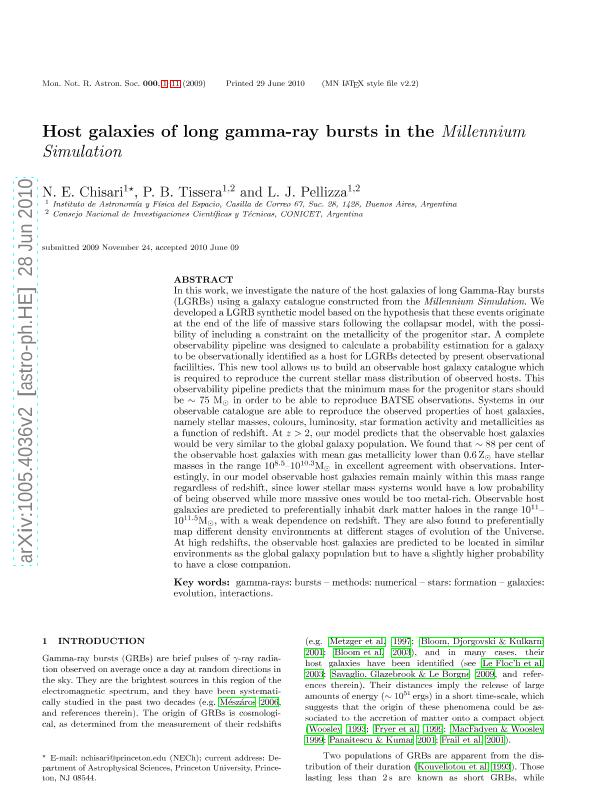Artículo
Host galaxies of long gamma-ray bursts in the Millennium Simulation
Fecha de publicación:
10/2010
Editorial:
Wiley Blackwell Publishing, Inc
Revista:
Monthly Notices of the Royal Astronomical Society
ISSN:
0035-8711
Idioma:
Inglés
Tipo de recurso:
Artículo publicado
Clasificación temática:
Resumen
In this work, we investigate the nature of the host galaxies of long Gamma-Ray bursts (LGRBs) using a galaxy catalogue constructed from the Millennium Simulation. We developed a LGRB synthetic model based on the hypothesis that these events originate at the end of the life of massive stars following the collapsar model, with the possibility of including a constraint on the metallicity of the progenitor star. A complete<br />observability pipeline was designed to calculate a probability estimation for a galaxy to be observationally identified as a host for LGRBs detected by present observational facililties. This new tool allows us to build an observable host galaxy catalogue which is required to reproduce the current stellar mass distribution of observed hosts. This observability pipeline predicts that the minimum mass for the progenitor stars should<br />be ~ 75 Msun in order to be able to reproduce BATSE observations. Systems in our observable catalogue are able to reproduce the observed properties of host galaxies, namely stellar masses, colours, luminosity, star formation activity and metallicities as a function of redshift. At z > 2, our model predicts that the observable host galaxies would be very similar to the global galaxy population. We found that ~ 88 per cent of<br />the observable host galaxies with mean gas metallicity lower than 0.6 Zsun have stellar masses in the range 10^8.5?10^10.3Msun in excellent agreement with observations. Interestingly, in our model observable host galaxies remain mainly within this mass range regardless of redshift, since lower stellar mass systems would have a low probability of being observed while more massive ones would be too metal-rich. Observable host galaxies are predicted to preferentially inhabit dark matter haloes in the range 10^11?10^11.5M, with a weak dependence on redshift. They are also found to preferentially map different density environments at different stages of evolution of the Universe. At high redshifts, the observable host galaxies are predicted to be located in similar environments as the global galaxy population but to have a slightly higher probability to have a close companion.
Archivos asociados
Licencia
Identificadores
Colecciones
Articulos(IAFE)
Articulos de INST.DE ASTRONOMIA Y FISICA DEL ESPACIO(I)
Articulos de INST.DE ASTRONOMIA Y FISICA DEL ESPACIO(I)
Citación
Chisari, N. E.; Tissera, Patricia Beatriz; Pellizza González, Leonardo Javier; Host galaxies of long gamma-ray bursts in the Millennium Simulation; Wiley Blackwell Publishing, Inc; Monthly Notices of the Royal Astronomical Society; 408; 1; 10-2010; 647-656
Compartir
Altmétricas




